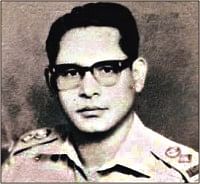<i>Freedom fighter Lt Col Qadir's grave traced after 36 years</i>

He disappeared at a time when people were being killed everyday, leaving his family in a sudden and total loss, from which they would never be able to recover.
Although the family could not make any headway in finding out his whereabouts they however kept at it relentlessly for over three decades.
Finally after 36 years of relentless search, journalist Nadeem Qadir traced the grave of his father, Lt Col Mohammad Abdul Qadir, a valiant son of the soil, who had disappeared following his arrest from his 70 Panchlaish residence in Chittagong by the invading Pakistani army on April 17, 1971 during the War of Liberation.
He was killed and buried in a mass grave only a ten-minute walk away form the erstwhile residence of the family.
Hasna Hena Qadir, wife of the martyred freedom fighter, passed away in 1999 still believing he would return any day, and their children also thought so. "But, I wanted to confront the truth, knowing quite well it would not be anything pleasant. Finding his last address was very important," said Nadeem.
In the early days of the family's search, The Red Cross informed them in 1974 that Lt Col Abdul Qadir of the Corps of Engineers was 'missing and believed killed' on April 17, 1971. Some people said he was killed in Foy's Lake area of Chittagong. "Considering his probable grave, I went there every year to pray and place flowers," Nadeem said.
He said he strengthened the search in 1991 when he had to go to Chittagong and to the south-eastern parts frequently for professional reasons. He went around with his father's picture in Panchlaish area several times asking people his father's whereabouts. "But, nothing came out with proof."
A chance knocked on his door finally in mid-November of 2007, when he went to Chittagong to deliver a lecture to a team aspiring to go to the UN Peacekeeping Mission in Sudan, where he shared his story of losing his father.
"Then came a big clue," he said adding that Lt Col Bayezid of the Chittagong brigade of the army showed him a book 'Bangaleer Jatiyabadi Sangram, Muktijuddhe Chattagram' (Nationalist Struggle of the Bangalee, Chittagong in Liberation War) written by researcher Dr Mahfuzur Rahman.
The author mentioned in the book that Lt Col Qadir was killed along with 35 others in Panchlaish behind Apollo Poly Clinic in front of Chittagong Medical College. "I tracked down Dr Rahman who took me to a witness, a businessman named Nurul Islam, who had been a member of the Chittagong chapter of Awami League in 1971," Nadeem said.
"The moment I was introduced, Islam broke down. He confirmed he knew my father and buried him along with at least 18 others in a vacant plot in Panchlaish on April 17, 1971," Nadeem went on adding that Nurul Islam said late Lt Col Qadir raised the flag of Bangladesh at his office as well as at his official residence in March, 1971.
The witness took much pain to guide Nadeem to the grave at 34/A Panchlaish where a house was under construction on top of it. Islam said on April 17, 1971 he heard shots around 2:00pm and later was informed by the guards and domestic helps of nearby houses about the killing of people including Lt Col Qadir.
Pointing to the mass grave, Islam told Nadeem that he called the Imam of local Makkhi mosque and buried the dead after a funeral in the plot close to the major drain flowing through the area.
"As I looked at the site, I wanted to yell out:: Papa, I have finally found you! Your Antu Baba is here, but I could not cry aloud, rather wiped my tears so none could notice, and prayed silently," said Nadeem.
He said he was lost for a moment and fell sick. "But, I couldn't afford that either. I prayed to Allah to give me strength to restore and protect the site where my father is sleeping."
Nadeem said he also came across Rokeya Chowdhury, a teacher of Cantonment Public School and College, who also showed him the same place as the area of the mass grave. She too heard that a Bangalee military officer was buried there.
He tracked down one Abdul Hakim, a retired businessman residing very close to the mass grave, who confirmed his domestic help Alauddin of Dohar was among those who buried the dead and pointed out the place.
As Nadeem informed the authorities about his findings, they on January 10 stopped the construction work of the building on the plot. "We need to speedily protect the area to honour those killed and buried there for the great cause of the nation," Nadeem stressed.
He said a local task force of the army also investigated the matter and found Nadeem's findings to be accurate. Officers in the Army Headquarters informed him that the army chief also came to know about his findings and is considering ways to protect the mass grave.
"I still sigh because my mother won't know of today's finding," those were Nadeem's sombre words in conclusion.

 For all latest news, follow The Daily Star's Google News channel.
For all latest news, follow The Daily Star's Google News channel. 



Comments